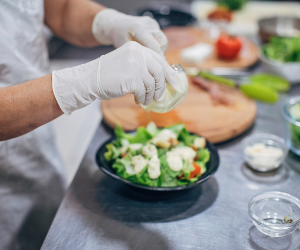In what seems to be an overnight boom, ghost kitchens have skyrocketed. While ghost kitchens have been regarded as a thing of the future since their start, virtual kitchens are now the restaurant industry’s newest addition to the take out and delivery model.
There are 100,000 and counting ghost kitchens in the United States, and food delivery services have surged in popularity in the last year alone. With a continuing increase in off-premise dining, ghost kitchens are taking center stage as an option that has benefits for both customers and restaurants.
What Are Ghost Kitchens?
Ghost kitchens, also known as virtual kitchens or cloud kitchens, are a shared kitchen space restaurants can rent out to prepare and send out delivery or carryout orders. The concept of ghost kitchens takes away the traditional brick and mortar setup of restaurants in favor of a larger kitchen and prep space with more accessible delivery areas. Customers can order from virtual kitchens using third-party delivery platforms or through your restaurant’s online ordering services.
Why Were Ghost Kitchens Predicted To Be Popular?

Shared kitchen spaces were predicted to become popular amongst restaurateurs as a way to make the most out of their budget, without sacrificing quality kitchen supplies and a prime location. Ghost kitchens are fully equipped the way traditional commercial kitchens would be and even offer adjustments based on the needs of your restaurant.
Ghost Kitchens Are Cost-Efficient
Renting out space at a ghost kitchen costs significantly less than designing a building or storefront with a dining area. For those looking to venture into the restaurant industry, ghost kitchens are a low-cost and low-risk option to get started.
Ghost Kitchens Are Pandemic-Friendly
With the current rise in social distancing, safety precautions, and a decrease in on-premise dining, ghost kitchens are designed to cater to the take out and delivery model. Virtual kitchens eliminate the need for a dining room to focus on optimizing take out and delivery orders, often dedicating an accessible area to organize orders for couriers or customers.
Ghost Kitchens Partner With Delivery Services
Ghost kitchens also offer ample space for several restaurant concepts and can be accommodating to social distancing standards. Virtual kitchens are ideal for connecting with third-party food delivery platforms, as they can connect with a wide range of potential customers while housing several restaurants in the same location.
How An Increase In Take Out Orders Led To An Increase In Ghost Kitchens

In the last decade, a shift from on-premise dining to take out and delivery services was predicted. However, in 2020, there was a significant surge in off-premise dining. The United States is the second-largest consumer of online food ordering, as one in three Americans is using a food ordering service on a weekly basis. One in three Americans is using a food ordering service on a weekly basis. On average, most people have at least two delivery apps on their devices and use them at least 3 times a month.
With the on-going pandemic and social distancing standards in place at restaurants across the country, the return to traditional on-premise dining isn’t guaranteed. 51% of Americans feel comfortable ordering for pickup from restaurants and 43% of Americans feel comfortable ordering delivery from restaurants. More than 45 million Americans use a food delivery platform already, and there’s been a 25% increase in the downloads of third-party delivery apps within the last year, according to data from US Foods. Even after the pandemic ends, many restaurateurs predict that the off-premise demand for dining will stay.
Ghost Kitchens Are On The Rise
Ghost kitchens have been popping up everywhere all across the country, due to the increased interest in delivery orders. Virtual kitchens are ideal to thrive in an environment where off-premise dining has taken center stage because they are designed to optimize the process of preparing delivery orders. Shared kitchen spaces house several food concepts in the same location, which makes it easier for customers to order a variety of cuisines while couriers can easily gather orders in the same location and deliver them faster.
Since traditional dining rooms are not being used at full capacity, ghost kitchens eliminate them in place of extra kitchen space. The limited number of employees needed to run a ghost kitchen is great for meeting social distancing requirements. Ghost kitchens are designed to take delivery orders from third-party platforms or restaurant ordering services directly to the kitchen. Most shared kitchen spaces are located in commercial hotspots which makes it easy for customers in the area to receive their orders quickly. Ghost kitchens are also designed to be flexible, low-risk, and operate on a month-to-month renting basis so you can easily start or shut down your business with little consequences.
What’s Next For Ghost Kitchens?

Virtual kitchens are predicted to continue to pop up around the world. Many investors have taken a fascination in ghost kitchens, providing the funding and interest in them. Much of the work needed to convert a traditional restaurant to a food delivery service has already been done in shared kitchen spaces, which is ideal for those looking to start in the restaurant industry without going over their budget.
Ghost kitchens will take on larger spaces, to create more room for different restaurant concepts. More and more virtual kitchens will keep appearing in local commercial areas to reach a larger audience. Restaurateurs have realized they don’t need a brick-and-mortar setup to run their business so there could be an increase in traditional restaurants converting into ghost kitchens to better meet the demand of off-premise dining. Since the increasing delivery habit is predicted to continue throughout and after the pandemic, it’s safe to say that ghost kitchens will remain as one of the main competitors in food delivery.








